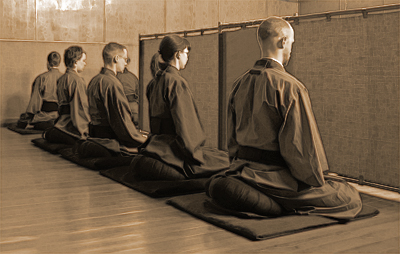
Martin Goodson
Should I Go On A Retreat?
As we are in the middle of the Rohatsu Sesshin week, now might be a good time to consider the pros and cons of going on retreat? This article looks at some things a potential participant might want to consider before making a decision.

Sesshin
Most Dharma centres run retreats at regular intervals during the year and inevitably, for the meditation practitioner, the question of whether or not to attempt one will arise.
For those who haven’t been on one the prospect can be quite daunting. However, Dharma teachers do recommend them to their students.
There are different versions of retreats in a variety of formats. For this article we are going to look specifically at the Zen Retreats that are called sesshins.
Sesshin is a term that is used in Japanese Buddhism to denote a period of retreat from the world, in which participants are secluded geographically and psychologically from the usual places, responsibilities and distractions of ordinary life, in order to experience a more intense practice of meditation and mindfulness.
The word ‘sesshin’ literally means ‘collecting the heart’, which implies the practice of restraint. This involves such practices as: not speaking for some or all of the time, restricting access to reading materials, restricting the use of phones, games and the internet etc. The effect of these practices is that the participants are left confronting themselves. This confrontation, coupled with the fact that so much of the time on retreat is regulated, with up to eight or ten hours of meditation (zazen) a day, does mean, that for beginners, the experience can feel like quite an ordeal.
I remember feeling great apprehension before going on my first sesshin, however I recall some advice given by Soko Morinaga Roshi on this anxiety, who asked: “Can you sit still for one stick of incense?” One stick lasts half an hour. The answer was “Yes.” He responded that that is all you have to do, because after that time you can move. This breaking down of a difficult ordeal into ‘bite-size’ psychologically manageable sections really did work!
The same goes when thinking about the sesshin as a whole. The length can be one, two, or five days, or up to a week long. Simply do not entertain the thought of whether or not ‘I’ can endure that length of time, just know that at this moment there are now two hours before the next meal and that ‘I’ will only have to sit for that.
What I discovered is that it is not the actual sesshin that is so difficult, but the prospect of managing my fear of it. I found this breaking down, or time-chunking to work well to ameliorate this. The first few times were both physically painful and mentally taxing, but they were by no means impossible. What I discovered is that I do have the inner strength to do them and that strength will present itself when the situation demands it.
When making the decision about whether or not to go, it is a good idea to survey one’s current practice. At a minimum one should be able to sit well for one hour (with a short two-minute break halfway through to relax the posture whilst remaining seated), five to six days per week. If one’s meditation practice is at this level, and one’s daily life practice and ability to contain the emotional fires using the precept practice and form practice are settled in, then one is ready to go.
The purpose of the sesshin is to push the student and create the conditions for that inner strength to emerge. This serves to deepen the practice when we return to our ordinary daily lives, which accumulates over the years, and is why people return for sesshin again and again.
It is generally true to say that no two sesshins are ever quite the same for a participant. Apart from the physical demands they can be quietening and joyful; they can also be mentally turbulent. One’s inner defences and reactions to constraint can bring up all sorts of psychological issues, such as parent/child and authority reactions from long ago. Petty jealousies can emerge and curious aversions to commonplace things, such as the sound of the person sitting next to you breathing, can become a ‘thing’. There is also the inner child to deal with, who might be seeking approval from an authority figure and when they cannot get that approval precipitate an angry tantrum or withdraw into a sulk.
The imposition of restraint is a powerful practice, which has been used for millennia to allow the emergence into consciousness of precisely these sorts of ‘hang-ups’, so that they can be investigated in the light of awareness, so that the source of them, as well as the path that leads to their ending, can be applied. This ‘dropping off’ of these basic anxieties caused by attachments to self-beliefs, allows the heart to find some true peace according to the Buddha’s own teachings: the way out of suffering is not by avoiding it, but by confronting it and discovering the inner strength that can overcome it.
………………………………..




